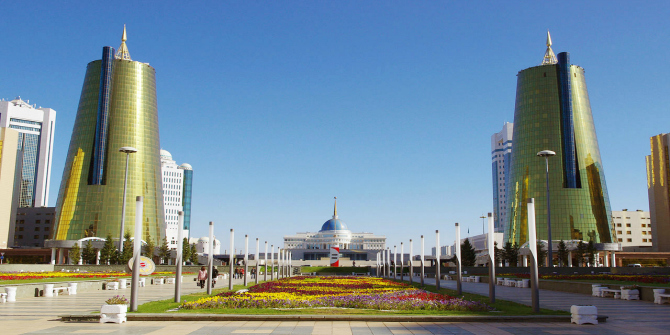 After decades of denial, the development community now acknowledges that effective assistance requires grappling with the domestic politics of recipient countries. Yet considerable controversy and confusion accompany this potential revolution in development aid, the subject covered in Development Aid Confronts Politics: The Almost Revolution. This book provides practical advice for decision-makers and practitioners, and readers interested in the future of aid and development, writes Lorenzo Ferrari.
After decades of denial, the development community now acknowledges that effective assistance requires grappling with the domestic politics of recipient countries. Yet considerable controversy and confusion accompany this potential revolution in development aid, the subject covered in Development Aid Confronts Politics: The Almost Revolution. This book provides practical advice for decision-makers and practitioners, and readers interested in the future of aid and development, writes Lorenzo Ferrari.
 Development Aid Confronts Politics: The Almost Revolution. Thomas Carothers and Diane de Gramont. Carnegie Endowment for International Peace. April 2013.
Development Aid Confronts Politics: The Almost Revolution. Thomas Carothers and Diane de Gramont. Carnegie Endowment for International Peace. April 2013.
Development aid should be more explicitly and more assertively political, according to Thomas Carothers and Diane de Gramont in Development Aid Confronts Politics: The Almost Revolution. For a long time efforts were made to keep politics and aid separate, but for Carothers and de Gramont aid should instead clearly pursue some political goals and should employ political means more extensively. According to the authors, the politicization of aid is not a matter of ideology; to “intentionally and openly think and act politically” would simply make aid more effective.
The purpose of this book is to analyse how political goals and methods have gradually entered developmental practice over the last few decades. By politics, the authors broadly refer to the dynamics of contestation and cooperation among social actors with differing interests and power. By development aid, they refer to bilateral and multilateral aid provided by governmental bodies and public international organizations. In particular, they look at the aid provided by the US, the EU and the other main Western countries, and at the aid provided by the World Bank, the IMF and the UN agencies. The analysis focuses on the last two decades, and it sketches also some perspectives for the future.
As is discussed in chapters 2 and 3, the “temptation of the technical” and an apolitical thrust prevailed during the 1970s and 1980s, with the breakthrough of politics occurring in the early 1990s. This breakthrough happened for two main reasons. On one side, the development community came to re-evaluate the importance of institutions for development: where institutions were too weak, such as in failed states like Afghanistan or Somalia, development could hardly be pursued. On the other side, the international context underwent major changes with the end of the Cold War. The perceived triumph of liberalism in international affairs pushed aid providers to pay more attention to democracy promotion, and that is why, for instance, USAID became the biggest funder of democracy aid in the world in the 1990s.
However, the embrace of political goals at this time was only partial: only 5 per cent of US development assistance was directed to the promotion of democracy in post-Soviet and developing countries. Moreover, the embrace of political goals was based on axiomatic assumptions, and it was kept sharply distinct from socio-economic aid – as was made clear in the case of Russia. Because of poor coordination between different domains, Western-promoted socio-economic reforms including privatization ended up creating a class of oligarchs whose activity undermined rather than strengthened democratic reforms. Much attention was put on governance, but its overtly political dimension was often downplayed.
The gradual advancement of political goals in the last two decades is discussed more extensively in chapter 4. In terms of politics, governance remained the focus of the development community. Good governance being not necessarily conducive to democracy, it allowed donors such as the World Bank – which are formally prohibited to engage in politics – to broaden their range of activities beyond merely socio-economic goals. However, as the case of UNDP showed, even when democratic governance was explicitly adopted as a goal, the most explicitly political aspects of aid had to be downplayed. Views integrating political and socio-economic goals, such as those of Amartya Sen, were not fully embraced. A clear division between the two kinds of goals persisted, and political goals continued to have a secondary importance, usually receiving between 5 and 15 per cent of available funds.
In chapter 5, the authors focus on the strategies aimed at enhancing citizens’ participation in development. Many strategies were initially top-down, such as the World Bank and IMF Poverty Reduction Strategy Papers, launched in 1999. Later on, efforts were made to foster participation from the bottom up. In particular, efforts were made in the so-called demand side of governance: OECD member states’ spending increased from $500 million in the mid-1990s to more than $3 billion in 2010. Despite persistent flaws and limits, Carothers and de Gramont see the shift in attention to the demand side of governance as “a major breakthrough”, likely to be a lasting one. Other advancements in political methods were made thanks to the refinement of political economy analyses, which allowed for an improved understanding of development processes.
A key word in the book is “yet”. Progress is made – yet obstacles persist, yet diffidence remains, yet timidity prevails. The authors recognize that politics has gradually entered development aid, but changes in goals and means have not been systematically accepted. What has happened is, at best, a partially realized revolution. Is the very notion of “revolution” appropriate in this context? Attempts at politicizing aid were made before the 1990s, while political goals and means still have a long way to go before being fully embraced.
Carothers and de Gramont adopt quite a broad understanding of politics, which allows them to explore the different roles that politics plays in the design and implementation of aid. What is striking for a book entirely focused on the relationship between politics and development, is that the authors do not provide any explicit definition of what they mean by development. As they point out, the debate on the relationship between socio-economic and political (or democratic) development is still open. Development itself is still a contested and debated concept: a greater clarity on the authors’ own understanding of development would have been useful.
The authors’ case for a larger role for political goals and means in aid is clear and it is made consistently throughout the book. Structure and exposition of the argument are clear, and the theoretical parts of the book are complemented by examples and case studies. Empirical evidence is remarkable for its breadth, covering many different aid providers. The book mainly addresses experts in the field but it is accessible to a larger audience interested in development aid and democratization. Not only does it address people studying aid, but also decision-makers and practitioners, providing them practical advice for further advancing along the political road.
—————————
Lorenzo Ferrari is a PhD student at the IMT Institute for Advanced Studies in Lucca. He works on European integration history and on the history of international relations, focusing on the external policies of the EC/EU. He holds a BA in International Studies and an MA in Contemporary History, both from the University of Bologna. Lorenzo also tweets @lorenzferrari. Read more reviews by Lorenzo.








2 Comments